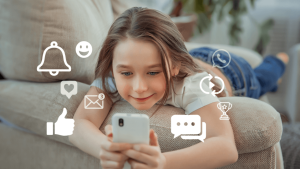
Do you find yourself mindlessly scrolling through Twitter or Instagram for hours on end? Have you ever attempted to watch one TV episode on Netflix, only to find yourself binging the series? If so, you’ve experienced the power of persuasive design, a set of sophisticated tactics used by device makers, software engineers, and social media platforms to manipulate your behavior and keep you glued to your screen. Borrowing insights from psychology and neuroscience, persuasive design can influence everything from what you purchase to how you engage in social interactions. Just as these tactics manipulate the behavior of adults, so too do they take time and control away from kids. Powerful and nearly ubiquitous, persuasive technology may seem impossible to avoid. Yet, experts agree that parents can take steps to reduce the impact of these techniques. Some of the world’s leading researchers and educators have weighed in with their suggestions below.
Understand The Challenge
In order to mitigate the consequences of persuasive design, parents must first understand what it is and how to spot it. “Persuasive design is the use of powerful behavioral psychology tricks to increase what’s known in the industry as ‘time on device,’” explains author and psychologist Richard Freed, PhD. “Without their knowledge or their parents’ consent, kids are manipulated into spending more time on entertainment technologies that pose both physical risks, such as obesity, and emotional consequences, including depression.”
In addition to increasing “time on device,” persuasive design can also influence what kids do on those devices. Sly design tactics can, for example, promote in-app purchases, or encourage children to view video content that they would not seek out on their own. Parents attempting to identify these techniques should keep an eye out for features that trigger prolonged use or that reward continued activity. These features, says author and Penn State Assistant Teaching Professor Meghan Owenz, PhD, include: auto-playing, notifications, reminders, and the use of “streaks,” as well as rewards like badges and points. These elements encourage screen habits that, over time, become very difficult to break.
Take Advantage Of Device Settings
Parents hoping to decrease the persuasive power of a child’s device may need to look no further than the device itself. Most phones allow users to limit or silence notifications, a step that will decrease the frequency with which the device buzzes, beeps, or otherwise screams for attention. Within the phone’s settings, parents can also set time limits on certain apps to ensure that their child’s use of those platforms remains under control.
Age Matters
Strategies for reducing a child’s use of persuasive technology vary according to age. “For parents of young children, I recommend not allowing persuasively designed programs, games, and applications at all,” says Owenz. “A young child’s mind won’t be able to recognize or fight the use of these manipulation techniques.” She suggests that parents instead direct their young kids toward media that encourages non-virtual activities, such as going outside, playing with the neighbors, or engaging in art projects.
Work Together
Unlike young kids, adolescents can learn to recognize the effects of persuasive technology if given the appropriate guidance. Owenz suggests that parents and teens take a critical look at media together in order to identify persuasive tactics in action. “Once persuasive design has been identified,” she explains, “encourage teenagers to discuss how their goals are different from the goals of the designer. Engage in conversations about how your teenager can develop habits, checks, and balances to ensure persuasive design does not manipulate their time.” Dr. Uhls agrees, adding that “Parents can help their tweens and teens by teaching them about the ways that social media sells them products (e.g., ads across platforms, influencers selling products in their posts).”
While kids are particularly susceptible to persuasive design, parents are hardly immune to its effects. As such, the entire family stands to benefit from conversations about healthy device use. The filmmakers behind The Social Dilemma suggest creating a Family Media Agreement to establish shared practices for tech habits in the house; they also recommend using a service like Mozilla’s Data Detox x Youth kit to help make everyone’s online experiences more safe and secure.
Lights Out!
Often, more “time on device” means less time asleep; and persuasive technologies excel at convincing kids to prioritize their devices over the rest that their bodies need. “Children who charge their cellphones in their bedrooms get 28 minutes less sleep per night than those who don’t,” says UCSF Emeritus Professor of Pediatrics Robert Lustig, MD, MSL. For this reason, Lustig recommends no screens for at least one hour before bed. “Yes, they’ll be bored,” he says, “but that’s the idea!”
Log Off And Live It Up
As powerful as devices have become, they can only attract your attention if they are turned on and in your possession. As such, Criscilla Benford, PhD suggests leaving your device at home as much as possible, and encouraging kids to do the same. “Start by shopping without your phone, then build up from there,” she says. “Phoneless shopping foils location-based marketing strategies, and it makes it easier for you to use your ‘down time,’ like standing in the checkout line, to daydream, check in with your own thoughts, or people-watch the old-fashioned way. All of these activities can boost your sense of wellbeing.”
Likewise, parents should ensure that kids have ample recreation time that doesn’t include their devices. “Make sure your young children have lots of opportunity to play away from the incessant (and insistent) chatter of apps and other digital entertainment,” says author and founder of the Campaign for a Commercial-Free Childhood Susan Linn, EdD. “Most of what children need to grow and flourish in the world is found off-line—in interactions with friends and family, time in nature, and hands-on exploration of their world. Kids learn best in relationship, so read to them, draw with them, dance with them, and help them develop a sense of themselves that comes from authentic experience, not from manipulation by tech companies competing for their attention.”
Despite the sophisticated design and ubiquity of persuasive technologies, they are not all-powerful. By following these tips, you and your kids can establish a healthy relationship with technology and maintain control of your time.



